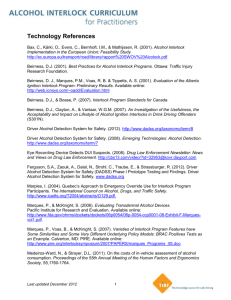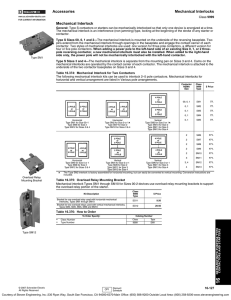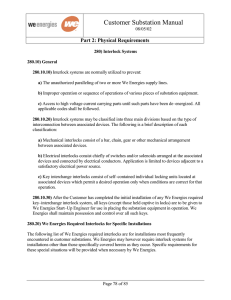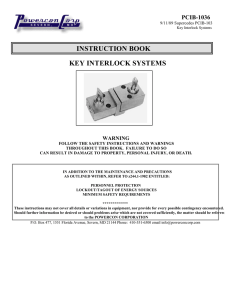Selection and Application of Key Interlock Systems - KIRK®
advertisement
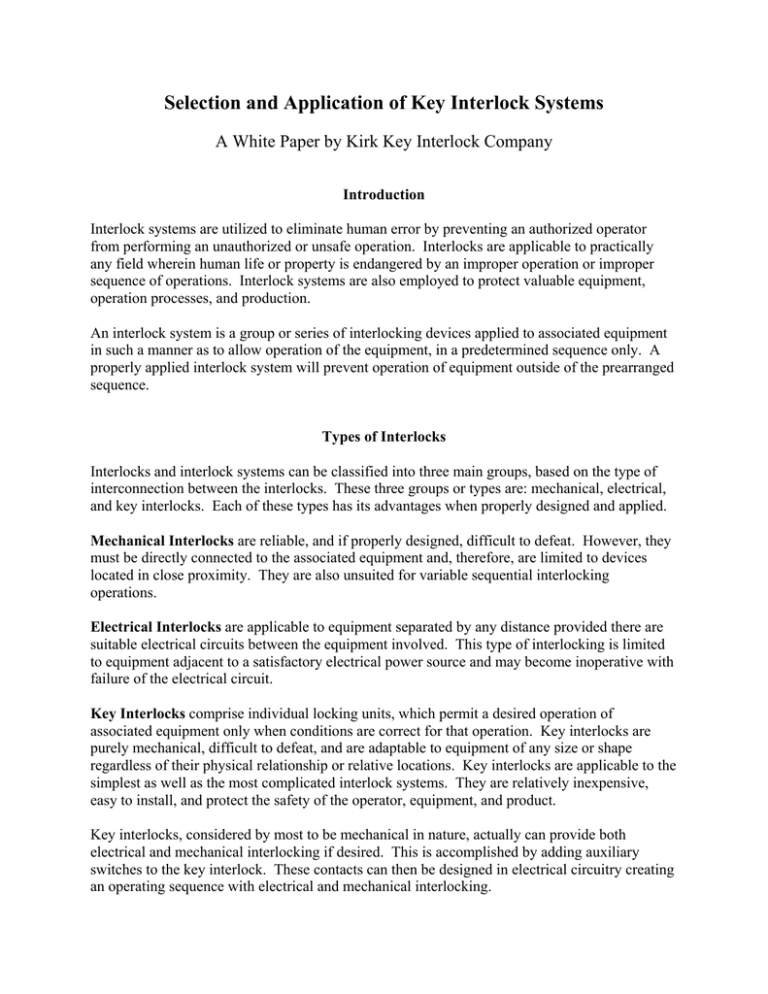
Selection and Application of Key Interlock Systems A White Paper by Kirk Key Interlock Company Introduction Interlock systems are utilized to eliminate human error by preventing an authorized operator from performing an unauthorized or unsafe operation. Interlocks are applicable to practically any field wherein human life or property is endangered by an improper operation or improper sequence of operations. Interlock systems are also employed to protect valuable equipment, operation processes, and production. An interlock system is a group or series of interlocking devices applied to associated equipment in such a manner as to allow operation of the equipment, in a predetermined sequence only. A properly applied interlock system will prevent operation of equipment outside of the prearranged sequence. Types of Interlocks Interlocks and interlock systems can be classified into three main groups, based on the type of interconnection between the interlocks. These three groups or types are: mechanical, electrical, and key interlocks. Each of these types has its advantages when properly designed and applied. Mechanical Interlocks are reliable, and if properly designed, difficult to defeat. However, they must be directly connected to the associated equipment and, therefore, are limited to devices located in close proximity. They are also unsuited for variable sequential interlocking operations. Electrical Interlocks are applicable to equipment separated by any distance provided there are suitable electrical circuits between the equipment involved. This type of interlocking is limited to equipment adjacent to a satisfactory electrical power source and may become inoperative with failure of the electrical circuit. Key Interlocks comprise individual locking units, which permit a desired operation of associated equipment only when conditions are correct for that operation. Key interlocks are purely mechanical, difficult to defeat, and are adaptable to equipment of any size or shape regardless of their physical relationship or relative locations. Key interlocks are applicable to the simplest as well as the most complicated interlock systems. They are relatively inexpensive, easy to install, and protect the safety of the operator, equipment, and product. Key interlocks, considered by most to be mechanical in nature, actually can provide both electrical and mechanical interlocking if desired. This is accomplished by adding auxiliary switches to the key interlock. These contacts can then be designed in electrical circuitry creating an operating sequence with electrical and mechanical interlocking. This paper will be confined to key interlocks and key interlock systems. Interlock Lock and Key Requirements The general interlock components utilized in key interlock systems include: • lock • supporting housing • movable locking bolt • cam arranged to move the bolt in response to the operation of a correct key in the lock The degree of safety achieved in key interlock systems depends almost entirely upon the accuracy and quality of the locks and keys employed, and the judicious choice of the specific locks and keys used in an interlock system. Key interlock locks must, therefore, meet certain basic requirements distinct from the normal commercial type of lock. The basic requirements of locks for key interlocks include: 1. All keys and locks of each combination must be interchangeable, i.e., any key will operate all locks having the same combination, regardless of year or date of shipment of the locks and keys. 2. No key will operate any lock other than those having the same combination as the key. 3. The key should be removable only in a predetermined position, (i.e. when the bolt is extended or withdrawn) depending upon the requirement of the equipment to which the interlock is mounted and the design of the overall interlock system. In addition, all locks and keys for interlocking purposes should be bitted from a bitting list that meets the requirements of a 2x2 bitting list. In other words, each lock and key combination in the entire bitting list must differ from all other combinations in the bitting list, by at least two pins having a minimum difference in bitting depth of two steps. Figure 1 shows the cross section of a lock cylinder. The term “bitting list” refers to the combination of pins and drivers in each cylinder. When the proper key is inserted in the plug of the lock cylinder, the interface between each pin and its driver aligns with the plug circumference (shear line) allowing the turned key to rotate the plug and operate the lock bolt. How is the key trapped in the lock cylinder? When the key and plug of the lock cylinder are turned, pin movement is blocked and the key cannot be withdrawn from the lock. Figure 1 In summary, locks for interlocking purposes must meet certain basic requirements that place these locks in an exclusive class. They must meet and pass numerous strict specifications and inspections far greater and more exacting than those required for ordinary commercial locks. Locks for interlocking actually become high-quality, specialized safety locks suitable for key interlocking purposes, designed for a unique purpose and application, even while looking and operating like a common commercial lock. Interlock System Coordination The key interlock manufacturer must keep complete records of all interlocks furnished to each ultimate user, as well as their location and general application. Because each interlock application is unique, individual treatment is necessary in order to provide the correct application in each specific interlock system. The accuracy and completeness of the interlock records are major factors in a properly coordinated interlock system. These records guarantee that only correctly combinated locks are used. The records are intangible hidden values furnished by the interlock supplier and enable existing interlock systems to be properly serviced, expanded, or modified at any time, without danger of subsequent incorrect operations. Key interlock systems can be developed and arranged to meet almost any type of interlock problem. In general, interlock system arrangements and/or functional requirements can be prepared by at least one of three different groups. These groups are 1) the actual ultimate users of the key interlocks, 2) the engineering consultants or suppliers of equipment upon which the interlocks are installed, and 3) the key interlock manufacturer. Regardless of who prepares the interlock system arrangement or its operating functional requirements, all information for each installation must funnel through the key interlock manufacture’s department responsible for assignment of the proper combinations of the locks and keys. After assembly, each lock and key must be completely inspected in order to guarantee delivery of correctly combinated interlocks. For more information about interlocks and interlock systems contact: Kirk Key Interlock Company 9048 Meridian Circle NW North Canton, Ohio, 44720 Phone: 1.800.438.2442 or 1.234.209.9031 Fax: 1.330.497.4400 Email: sales@kirkkey.com Or visit our web site at http://www.kirkkey.com
